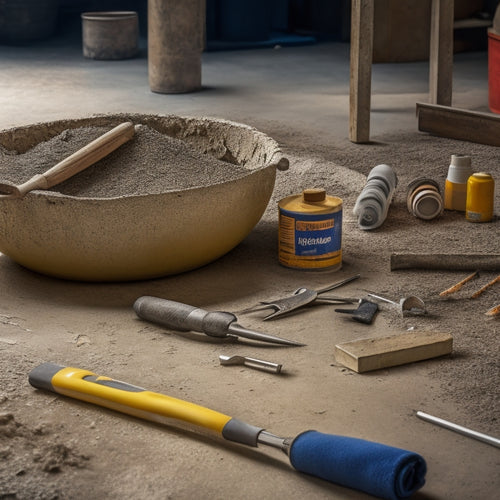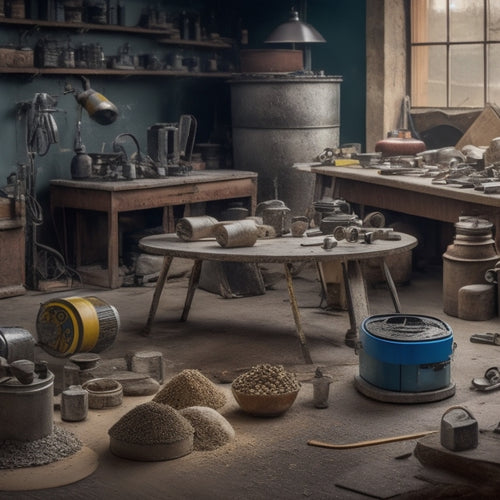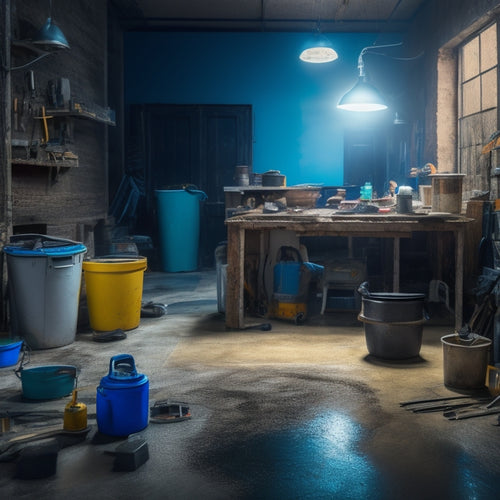
7 Must-Have Tools for Concrete Stamping DIY
Share
To achieve professional-looking results in your concrete stamping DIY project, you'll need seven essential tools. First, select stamp mat designs that fit your theme, style, and color scheme. Next, add patterned texture skin tools to enhance texture and visual appeal. Concrete stamping tamping tools, including hand tampers and vibrating plates, guarantee a smooth finish. Apply colorants and sealers with high-quality sprayers, brushes, and rollers. Don't forget stamp edge and corner tools for seamless patterns. Proper concrete surface preparation and safety measures, such as personal protective equipment and hazard management, are also vital. Now that you have these must-haves, you're ready to take your concrete stamping skills to the next level.
Key Takeaways
• Stamp mat designs are essential for creating unique patterns and combining different mats produces one-of-a-kind designs.
• Patterned texture skin tools enhance texture and visual appeal, providing intricate details and subtle variations.
• Concrete stamping tamping tools, including hand tampers and bull floats, remove excess water and air, and compact concrete effectively.
• Colorant and sealer applicators, such as sprayers and rollers, are necessary for achieving desired colors and protecting the concrete.
• Safety and protection essentials, including gloves and safety glasses, are crucial for preventing injuries and ensuring a successful DIY project.
Essential Stamp Mat Designs
What specific patterns do you need to achieve the desired texture and visual appeal in your concrete stamping project?
Choosing the right stamp mat design is essential to achieving a professional-looking finish. Popular stamp designs, such as ashlar slate, fieldstone, and wood plank, are staples in the concrete stamping industry. These designs can add depth, texture, and realism to your project.
However, you can also experiment with creative stamping techniques to create unique patterns that set your project apart. For instance, you can combine different stamp mats to create a one-of-a-kind design or use a single stamp mat in a repetitive pattern to create a cohesive look.
When selecting a stamp mat design, consider the theme, style, and color scheme of your project. You can also experiment with different stamp mat sizes, shapes, and materials to achieve the desired effect.
Patterned Texture Skin Tools
You can further enhance the texture and visual appeal of your concrete stamping project by incorporating patterned texture skin tools, which offer a more subtle, nuanced approach to achieving desired patterns and textures.
These tools allow you to add intricate details and subtle variations to your stamp mat designs, giving your concrete a more realistic, natural look.
Patterned texture skin tools come in various texture skin types, such as rock, stone, and wood, each providing a unique visual effect.
By combining different texture skin types with stamp pattern variations, you can create a wide range of designs that mimic natural materials.
For example, you can use a rock texture skin with a flagstone stamp pattern to create a realistic stone-like surface. Alternatively, you can pair a wood texture skin with a wood plank stamp pattern to achieve a convincing wooden appearance.
With patterned texture skin tools, the possibilities are endless, and you can experiment with different combinations to achieve the desired look for your concrete stamping project.
Concrete Stamping Tamping Tools
Once you've achieved the desired texture and pattern with your stamp mat and patterned texture skin tools, it's essential to ascertain even consolidation and uniform density throughout the concrete using concrete stamping tamping tools.
This step is critical to prevent air pockets, unevenness, and weak spots in the finished product.
To achieve the best results, you'll need to employ the right tamping techniques and tamping equipment.
Here are some essential tools to add to your arsenal:
-
Hand tampers: These handheld tools are used for small, intricate areas and are ideal for getting into tight spaces.
-
Bull floats: These large, flat tools are perfect for larger areas and help to remove excess water and air from the surface.
-
Tamping rods: Long, sturdy rods with a flat or rounded end, used to compact and consolidate the concrete.
- Vibrating plates: These power tools use vibrations to compact and settle the concrete, ensuring a smooth, even finish.
Colorant and Sealer Applicators
Now that your concrete is stamped and consolidated, it's time to add color and protection with the right colorant and sealer applicators. You'll need a range of tools to achieve a professional-looking finish.
For colorant application, you'll require a high-quality sprayer or brush to evenly distribute the colorant across the surface. Consider investing in a low-pressure sprayer, which provides better control and reduces overspray.
When it comes to sealer techniques, you'll need a variety of rollers, brushes, and squeegees to apply the sealer evenly and efficiently. A microfiber roller is ideal for applying solvent-based sealers, while a foam roller is better suited for water-based sealers.
Don't forget to invest in a sealer sprayer, which allows you to apply the sealer quickly and evenly.
With the right colorant and sealer applicators, you'll be able to achieve a beautiful, long-lasting finish that enhances the beauty of your stamped concrete. By mastering these tools and techniques, you'll be able to take your DIY project to the next level.
Stamp Edge and Corner Tools
Several precision-crafted tools are necessary to create crisp, defined edges and corners in your stamped concrete design. You'll need these specialized tools to achieve professional-looking results.
To master corner stamp techniques and edge finishing methods, you'll require the following essential tools:
-
Corner Stamps: These tools are specifically designed to fit snugly into corners, allowing you to create seamless patterns and textures.
-
Edge Chisels: These chisels help you remove excess concrete and create a clean, defined edge.
-
Radius Edge Tools: These tools enable you to create curved edges and corners, adding visual interest to your design.
- Edge Trowels: These trowels are used to smooth and finish edges, ensuring a uniform appearance.
Concrete Surface Preparation
You'll need to prepare your concrete surface before stamping, as a well-prepared surface guarantees a strong bond between the concrete and the stamping tools. This involves thorough concrete surface cleaning to remove dirt, oil, and other contaminants that might hinder the bonding process. Use a pressure washer or a stiff-bristled brush to scrub the surface, and then rinse it with clean water.
After cleaning, inspect the surface for any imperfections or unevenness. Employ surface leveling techniques, such as applying a self-leveling compound or using a screed board, to confirm the surface is even and smooth. This is essential, as an uneven surface can lead to an inconsistent stamp pattern.
Additionally, check the surface for any cracks or joints that may need to be filled or sealed. Use a concrete patching compound to fill in any gaps, and let it dry according to the manufacturer's instructions.
A well-prepared surface won't only confirm a strong bond but also a professional-looking finish. By following these steps, you'll be ready to move on to the stamping process with confidence.
Safety and Protection Essentials
As you prepare to stamp your concrete, you'll need to prioritize safety and protection to avoid injuries and damage.
You'll want to gear up with personal protective equipment like gloves, safety glasses, and a dust mask to shield yourself from hazardous materials and debris.
Additionally, you'll need to identify and mitigate job site hazards, such as slippery surfaces and falling objects, to guarantee a successful and incident-free project.
Personal Protective Gear
Wearing personal protective gear, including a dust mask, safety glasses, and gloves, is essential when working with concrete stamping tools to prevent respiratory problems and physical injuries.
You'll be exposed to dust, debris, and harsh chemicals, so it's vital to protect yourself from head to toe.
Here are some must-haves for your personal protective gear arsenal:
-
Respiratory masks: Look for ones with a HEPA filter or those specifically designed for concrete dust to guarantee you're breathing safely.
-
Safety glasses: Choose glasses with polycarbonate lenses and a wrap-around design to protect your eyes from flying particles.
-
Dust-resistant coveralls: These will help contain dust and debris, making cleanup easier and reducing the risk of skin irritation.
- Chemical-resistant gloves: Select gloves with a waterproof coating and a grip to prevent slipping, assuring your hands stay protected and dry.
Job Site Hazards
Before commencing concrete stamping, survey the job site to identify potential hazards. Look for uneven terrain, tripping obstacles, and overhead dangers, which can cause accidents and injuries if left unchecked.
As you walk through the site, take note of any hazards that could impact your work, such as slippery surfaces, exposed wiring, or falling objects. This process is essential for hazard identification, allowing you to take necessary precautions to mitigate risks.
Next, perform a risk assessment to evaluate the likelihood and potential impact of each identified hazard. Consider factors such as the severity of the hazard, the frequency of exposure, and the number of people at risk.
This will help you prioritize hazards and focus on the most critical areas.
Frequently Asked Questions
Can I Use a Regular Trowel for Concrete Stamping?
You shouldn't use a regular trowel for concrete stamping, as it's not designed for the specific trowel techniques required; instead, invest in a stamping trowel with a stiffer blade and optimized angle for precise pattern control.
How Do I Achieve a Consistent Stamp Pattern?
Did you know that 80% of concrete stamping projects fail due to inconsistent patterns? To achieve a consistent stamp pattern, you'll need to master pattern alignment and develop a precise stamp technique, ensuring seamless changes between stamps.
Can I Stamp Concrete in Cold Weather Conditions?
When you're planning to stamp concrete in cold weather, take cold weather precautions seriously, as they'll impact your stamper's performance and concrete's curing process. Adjust your stamper's weight, and refine your stamper techniques to guarantee a successful, high-quality finish.
What Is the Ideal Concrete Mix for Stamping?
Imagine a warm summer day, and you're stamping a patio with a intricate stone pattern. For perfect stamping, you'll want a mix with a 3:2:1 ratio of cement:sand:aggregate, allowing for best workability and strength for various stamping techniques.
How Long Does It Take for Stamped Concrete to Fully Cure?
You'll need to wait around 28 days for stamped concrete to fully cure, but be patient, as the curing process can take up to 6 months for maximum strength, with curing time depending on temperature, humidity, and mix design.
Conclusion
You've got the know-how, and now you've got the tools.
Will you be able to transform that dull, gray slab into a stunning work of art?
With these 7 must-have tools for concrete stamping DIY, the possibilities are endless.
From essential stamp mat designs to safety and protection essentials, you're equipped to take on any project.
So, what're you waiting for?
Get stamping and turn that concrete into a masterpiece!
Related Posts
-

Top Tools for Repairing Cracked Concrete Surfaces
When tackling a cracked concrete surface repair, you'll need the right tools to guarantee a durable fix. Start with e...
-

Top DIY Concrete Grinding and Polishing Tools
When selecting DIY concrete grinding and polishing tools, you'll want to take into account a range of factors to guar...
-

Essential Tools for Epoxy Concrete Floor Repair
You'll need a thorough arsenal of specialized tools to guarantee a successful epoxy concrete floor repair. Floor prep...


